A Private Tour today, in North Norfolk. It was a bright but mostly cloudy morning, with intermittent dark clouds spreading in particularly from early afternoon and bringing with them some torrential showers. Thankfully we mostly managed to avoid being caught out in the worst of them.
We started the day at Snettisham. As we parked and got out of the minibus, a Cuckoo was singing, but it had gone quiet by the time we were ready to set off. As we walked into the Coastal Park, there were lots of warblers singing in the bushes, Common Whitethroats, Lesser Whitethroats and Blackcaps. Chiffchaffs too and we spotted one flicking around in some nearby trees.
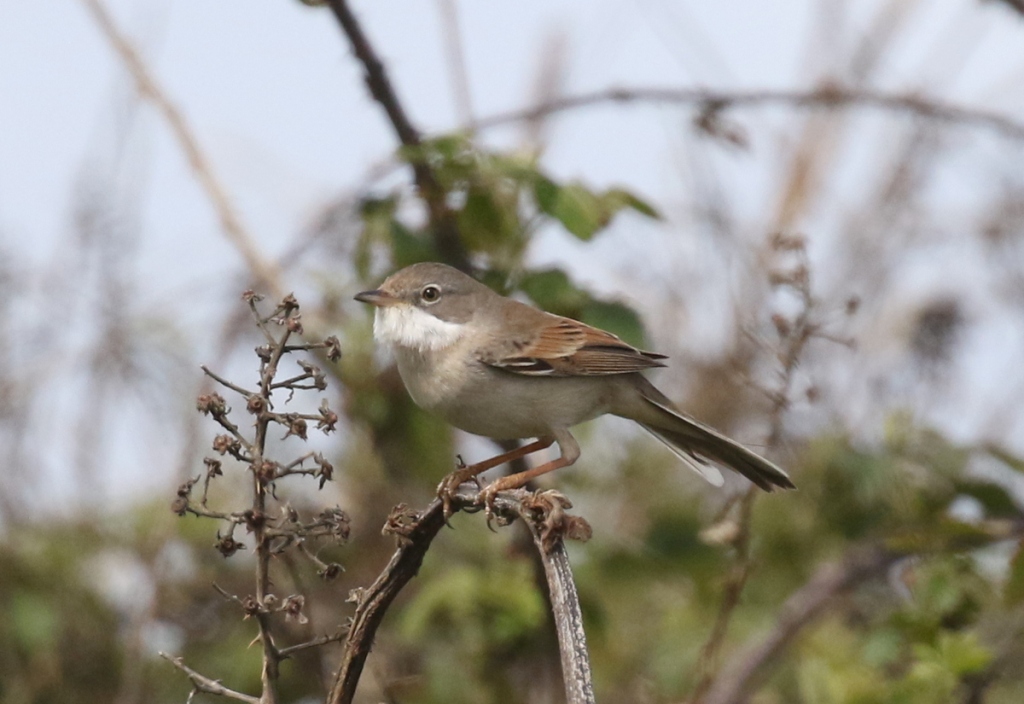
While we were watching the Chiffchaff, we heard a Turtle Dove purring from the bushes. We walked round on the path to try to locate it, and a second male started singing further over, one either side, stereo Turtle Doves! We had a couple of brief glimspses – first of a pair chasing through the bushes, then a male which flew up quickly and then slowly floated back down in display flight. One of the male Turtle Doves was purring now in a bush not far from the path but it was tucked in somewhere out of view. We caught a glimpse of that one as it slipped out the back and then went quiet. The other male was still purring in the thicker bushes the other side.
We walked in further and up onto the outer seawall. Looking out over the Wash, the tide was slowly going out. We had seen a couple of small groups of Oystercatchers flying past earlier, and there were now lots gathered on the exposed mud to the north. Four Bar-tailed Godwits were feeding on the shore, a Dunlin dropped in with them briefly and then another four Bar-tailed Godwits arrived. They were all either females or young birds, lacking the breeding male’s bright rufous underparts. Five Grey Plover flew past out over the water, a couple of them sporting their summer black faces and bellies. There were lots of Brent Geese on the beach too and two Common Terns distantly over the water.
When we turned round, we could see a Barn Owl hunting the other side, following the inner seawall. It was out late this morning – either the cold spring weather is not helping it to fatten up ahead of the breeding season, or it has hungry young to feed already, although there was no sign of it flying back to feed them.
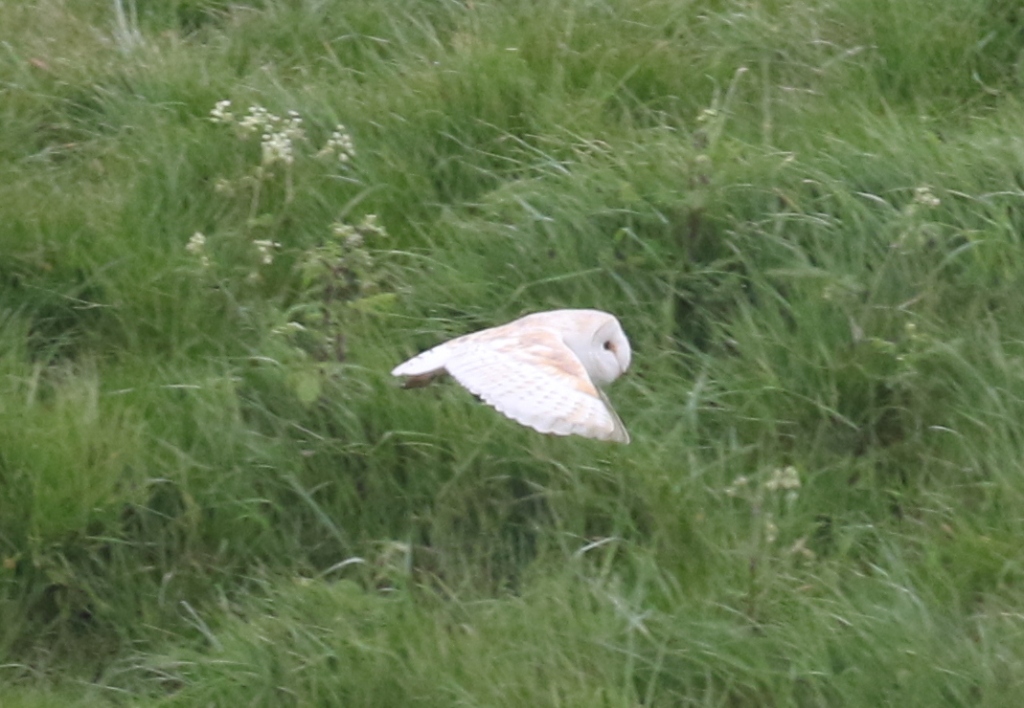
We walked back down into the bushes and up through the middle of the park. A Willow Warbler was singing in the sea buckthorn on the seawall and there were lots of Linnets in the bushes. When some darker clouds rolled overhead and it started spitting with rain briefly, there were suddenly lots of Common Swifts zooming back and forth low above us. Presumably migrants on their way over which were pushed down by the weather.
When we heard a Turtle Dove purring again, we looked up to see it perched in a dead tree. Now we had a great view of it through the scopes, with its rufous scaled back and black and white barred panel on the side of its neck. We stood for a while just listening to it now – a wonderful sound of spring, once common but now rare, and still declining at an alarming pace, a victim of the industrialisation of farming here and our obsession with flailing hedges and tidying up any areas of scrub in the countryside. Catch it while you still can!

A pair of Stonechats were alarm calling from the clumps of low gorse nearby, presumably with young in the nest somewhere. The Barn Owl appeared again, weaving in and out of the bushes over the grass.
As we carried on further, finally we heard a Cuckoo calling again, and could see it in the distance, in a tree right at the north end of the park. We got it in the scopes, but it was mobbed by a Meadow Pipit and took off. It flew our way, past us through the bushes, and landed in the same tree where the Turtle Dove was still purring. Two of the classic sounds of spring, both declining, together. We walked back, but the Cuckoo was off again before we could get there.
Carrying on north, we climbed up onto the seawall again. The tide had gone out considerably, with a lot more exposed mud, and the Oystercatchers and Brent Geese were widely scattered. A huge flock of thousands of Knot and Grey Plover flew round out in the middle, half way across to Lincolnshire, catching the light as they twisted and turned.
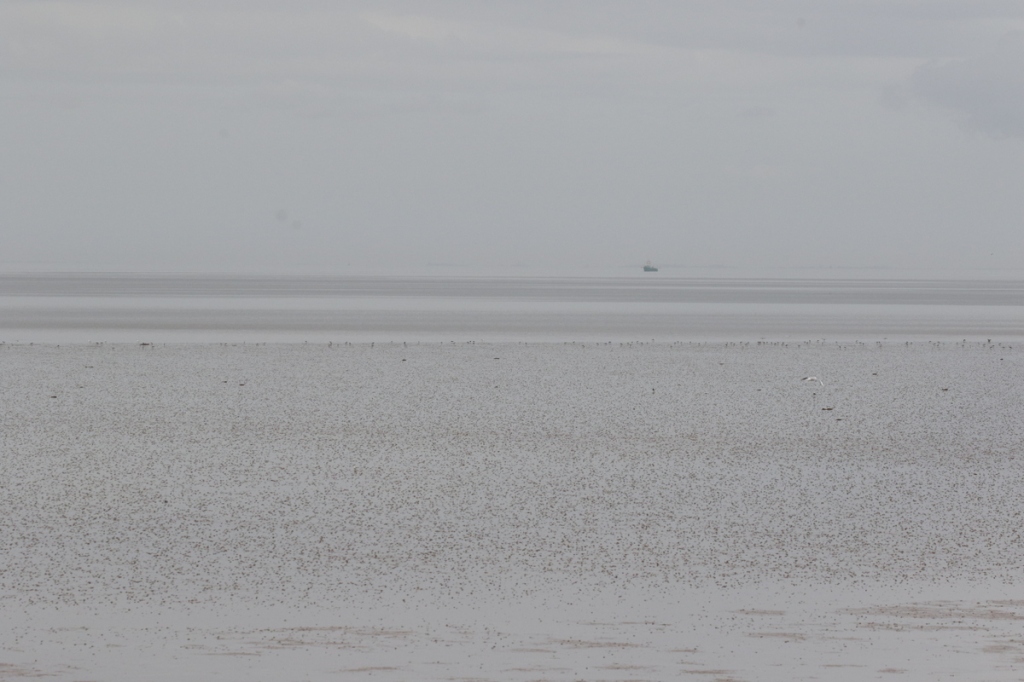
We walked along the crossbank to the inner seawall and climbed up to scan over Ken Hill Marshes. There were lots of ducks out here on the pools, including a late lingering Wigeon. A Russian White-fronted Goose swimming across one of the pools was a surprise, as most of the wild wintering geese have long since departed. A little further up, we picked out a single Pink-footed Goose too, with a small group of the resident Greylags. The Pink-footed Goose was probably winged and injured by wildfowlers, now unable to fly north with the others but still capable of feeding happily on the marshes, so perhaps the White-fronted Goose was too.

There were lots of Lapwings and Avocets out on the pools. Scanning carefully, we picked out a small group of Black-tailed Godwits at the back. A Ringed Plover together with a small group of Dunlin were feeding on a muddy island closer to us. A lone Whimbrel was down on the short grass nearby.
The Yellow Wagtails were on the move today. We had already heard and seen a few flying south overhead, and a group of four had just gone over. We were just about to move off, when we heard Yellow Wagtails call and turned to see a large group dropping down towards the grass on the near edge of the marshes. There were about a dozen of them, and it is always worth scanning through to see if any of their scarcer cousins are travelling with them. And there were two very smart male Grey-headed Wagtails together down on the grass.
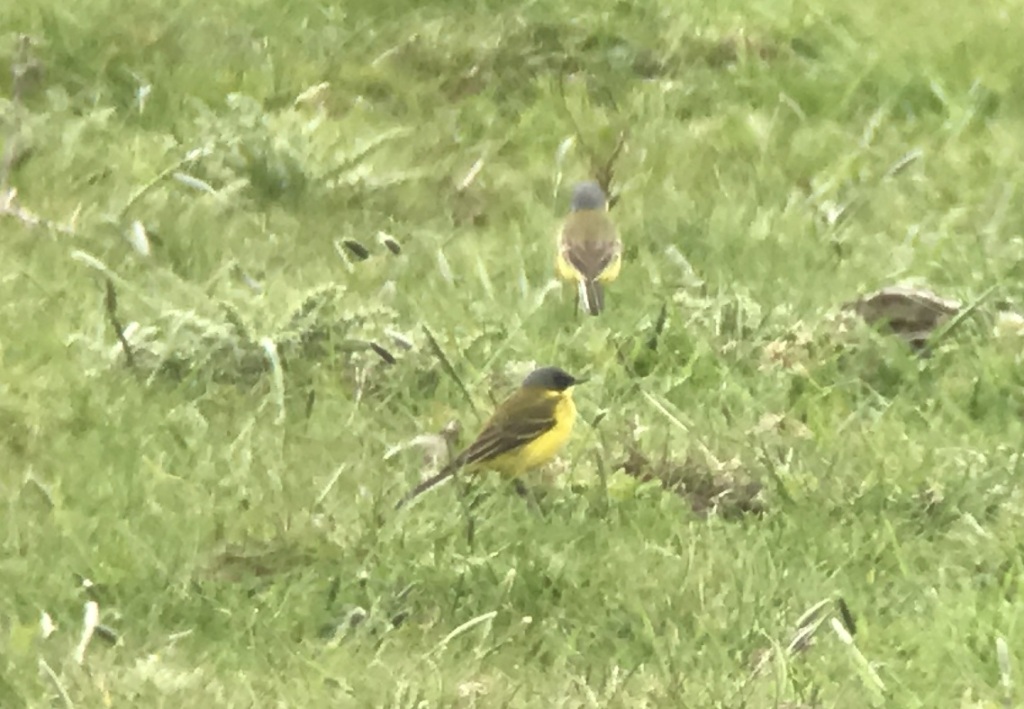
Looking through the rest of the flock, there were mostly yellow-headed British Yellow Wagtails, males and females, but one female had a noticeably greyer head and paler white supercilium. It is not possible to conclusively identify female Blue-headed Wagtails, as female British Yellow Wagtails are variable in appearance, but this looked like a good candidate.
Then we found another male Grey-headed Wagtail further over. This one appeared to have a tiny speck of white above the lores. All these yellow wagtails are considered just subspecies and they do interbreed – perhaps this little speck of white was a tiny remnant of historic intergradation with Blue-headed Wagtails where they meet in northern Scandinavia?
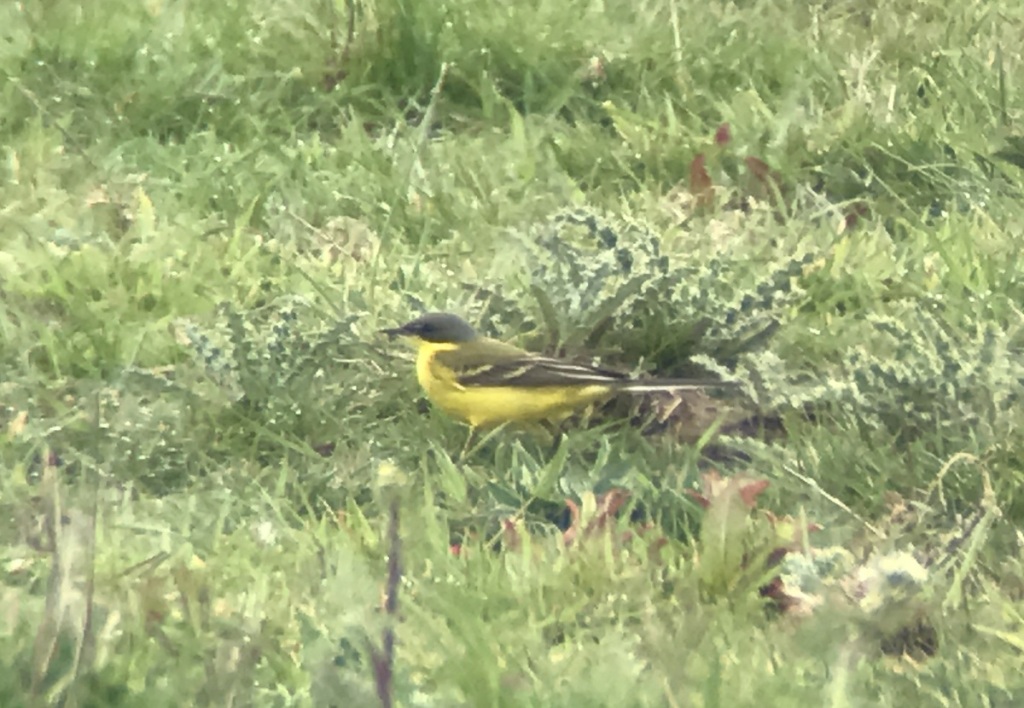
They may just be treated as subspecies of Western Yellow Wagtail and therefore not separate ‘ticks’ on the official list, but taxonomy is in a constant state of flux these days and definitions change of what makes a species (Eastern and Western Yellow Wagtail have recently been separated). Like many other families, the yellow wagtails with their myriad forms defy our crude attempts to put them into neat boxes. They are fascinating and beautiful things and well worth recording on our lists, species or not!
Having marvelled at the various Yellow Wagtails for a while, we started to make our way back along the seawall. The Cuckoo was singing from another dead tree, but dropped down before we got back level with it. We found it again and had a good view of it perched in the bushes by the outer seawall, before it was chased off by a Meadow Pipit again.

The sun was out and things had warmed up now. The Swifts were very high and we picked up a distant Hobby very high over the marshes, catching insects. There were several Common Buzzards up too, and some other distant raptors beyond the range of our scopes. The Turtle Dove was still in purring away in its favourite tree as we passed. We could see more dark clouds approaching from the south, so we made our way back to the minibus.
We made our way round to Holme and stopped briefly on Beach Road to use the facilities. Then we drove down the track past the payhut to park, and climbed up onto the seawall. It was grey but dry here, although the dark clouds we had seen from Snettisham were passing to the west of us and it looked to be raining over there. Two Hobbys were zooming back and forth low over the reeds out on the grazing marsh hawking for insects.
We could see dark clouds coming our way now, so we decided to have lunch down under the shelter of the minibus tailgate. One of the Hobbys landed on a bramble bush out on the grazing marsh briefly and a Great White Egret flew over. We waited for the shower to pass.
After lunch, it had stopped raining and we went back up onto the seawall again. There were several Marsh Harriers circling out over the reeds now. A lone Whimbrel appeared down on the grass closer to us. There were lots of Brent Geese still lingering on the saltmarsh. It shouldn’t be long before they are off back up to Siberia for the breeding season now. Another shower arrived, so we retired to the minibus again. It appeared to be brighter away to the east, so we decided to head round that way.
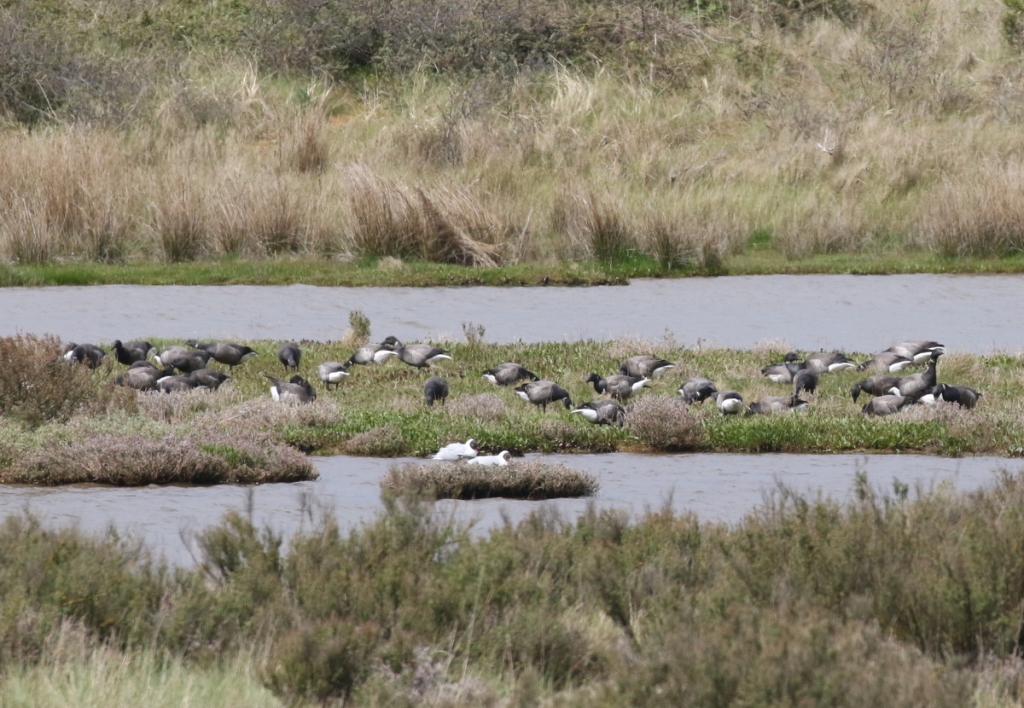
We diverted inland via Ringstead, scanning the fields while waiting for some more darker clouds to blow through, then swung round to Choseley. A single Corn Bunting was perched in the middle of a bright yellow oilseed rape field. We started to scan the field where the Dotterel had been recently, finding two Wheatears out amongst the stones, but it was starting to rain again now.

There was a report of a Temminck’s Stint at Stiffkey Fen, so we decided to drive further east to see if we could get out of the worst of the weather. At first, things deteriorated as we simply drove into torrential rain. But we could see brighter skies ahead of us and by the time Stiffkey it had stopped raining, even if we were still just under the edge of the darker clouds.
It was cool and breezy now and there weren’t many birds singing as we walked out beside the river. We headed straight out and up onto the seawall, and it was good we didn’t dawdle. There were a couple of people already there and we saw them lift their heads and start to scan with their binoculars as we got to the top of the steps – everything on the Fen had taken off. We stopped and heard the Temminck’s Stint call, as it flew over the seawall just ahead of us. We watched as it flew out over the saltmarsh and dropped down into a channel out of view. Just in time!
The Common Sandpiper which had been feeding on the Fen had returned, so we could still see that working its way round one of the islands. We decided to walk on round to the edge of the harbour to see if we could see into the channel where the stint had landed. We could see a small area of mud, but it was obviously further round the corner, still out of view from here.
There were still plenty of Brent Geese here too. With the tide out, there were lots of gulls loafing on the mud. Further back, we could see terns flying back and forth over the remaining water in the pit, lots of Common Terns and one or two Little Terns. We could see seals in the distance too, hauled out on the sandbank beyond the far end of Blakeney Point.
It was starting to spit with rain again, but it was time to head back anyway. A Garden Warbler was singing in the sallows as we walked back beside the river and we heard a Kingfisher call as it flew upstream along the channel behind the bushes and brambles. Then it was back up to the road to finish.
















